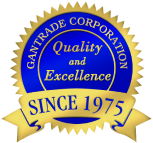Chemical safety begins with the Safety Data Sheet (SDS). Gantrade makes these available to customers, prospective customers, and other interested parties. Basic safety information is summarized in sec. 2 with signal word, pictograms, and hazard (“H”) statements that provide rapid identification of the hazards (if any) posed by the material. Precautionary (“P”) statements given further information on to deal with the hazards, such as protective equipment that should be worn, conditions to avoid when handling the material, &c. These signal words, pictograms, and statements align with the international Globally Harmonized System of Classification and Labelling of Chemicals (GHS) and are recognized around the world.
There are two signal words that can be used on an SDS:
- WARNING – the material poses a significant risk to the health and safety of the user
- DANGER – the material presents a great and usually immediate hazard to the user
The pictograms that can appear on an SDS are as follows:

There are dozens of H statements under GHS. These are often (but not always) shown on an SDS as Hxxx. The first digit after the H indicates the type of hazard:
- H2xx – physical hazard such as explosive, flammable, corrosive to metal, &c.
- H3xx – health hazard such as toxic, corrosive to skin or eyes, carcinogenic, &c.
- H4xx – environmental hazard such as toxic to aquatic life. Note that US regulations do not require statements about environmental hazards on the SDS
Whether the particular H number is shown on the SDS, the hazard statement is standard around the world. For example, one may see either of these on an SDS:
- H302 Harmful if swallowed
The body of the SDS is divided into sixteen sections (note that US regulations do not require all sections to be complete):
- The chemical identification of the substance / its components is found in sec. 3 of the SDS. Note that US regulations allow for non-hazardous components, or the concentration of hazardous components, to be listed as “trade secrets”. Nevertheless, the SDS must convey accurate safety information!
- More detailed information about the safe storage and handling of the material is found in sec. 7. This includes such information as storage temperature, materials that should not be stored with / near the substance (“incompatible substances”), protection from light or temperature extremes, &c.
- More detailed information about protective measures, including personal protective equipment (PPE) that should be worn, is found in sec. 8.
- More detailed information about the stability of the material can be found in sec. 10.
- It is an employer’s responsibility to provide Safety Data Sheets for employees who may be exposed to hazardous chemicals!
In addition to the Safety Data Sheet, the product label includes a summary of the hazards posed by a material, including the signal word, pictogram, H statements, and P statements.
For certain types of chemicals that have particular hazards or storage requirements, Gantrade is happy to provide industry standard Safe Handling Guides. Please ask your salesperson.
Gantrade urges that its customers make themselves and their employees fully aware of any hazards associated with the materials they purchase, store and use and conduct regular and thorough training in hazard communication and hazardous material handling.




















